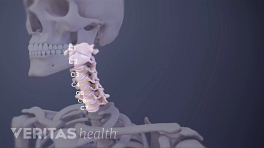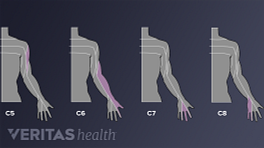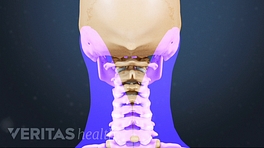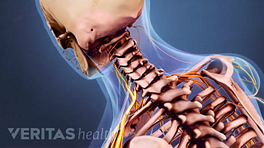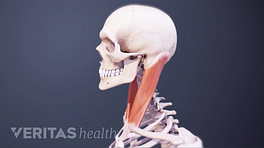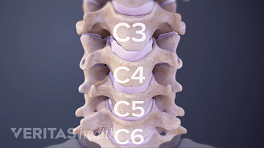The spinal cord is a critical bundle of nerve cells that carry electrical signals to and from the brain. One of the cervical spine’s important roles is to protect the spinal cord as nerve cells communicate with each other throughout the body.
Nerve cells have three basic parts: a cell body, dendrites for receiving signals, and an axon for sending signals to other nerve cells. To understand how these signals flow through the neck region, let’s explore the spinal cord’s anatomy.
A cross-section view of the spinal cord contains a butterfly-shaped region of gray matter surrounded by white matter.
The gray matter mostly consists of nerve cell bodies. Both sides of this region have a posterior horn and anterior horn. The posterior horn is the back section that connects with the posterior nerve root. It receives sensory signals, such as for pain, temperature, and touch. The anterior horn is the front section that connects with the anterior nerve root and sends motor signals to control muscles. Motor signals that exit the spinal cord in the neck region are sent to parts of the upper body.
The white matter mostly consists of axons that carry the electrical signals. Bundles of these axons are called tracts. Ascending tracts carry sensory signals up toward the brain, while descending tracts carry motor signals out toward the muscles.
The spinal meninges help protect the spinal cord and contain three layers. The dura mater is the outermost layer and constructed of dense fibrous tissue. It is the only layer of the spinal meninges that can feel pain. The arachnoid mater is the middle layer and has elastic tissues and collagen in a spider web-like network. The pia mater is the innermost layer and directly attaches to the spinal cord. This layer is the slimmest and most delicate. The cerebrospinal fluid—which adds protection—flows in the subarachnoid space between the arachnoid mater and pia mater.
If the spinal cord becomes compressed within the cervical spine, pain or neurological deficits may be experienced in the arms, legs, or anywhere below the level of compression.

